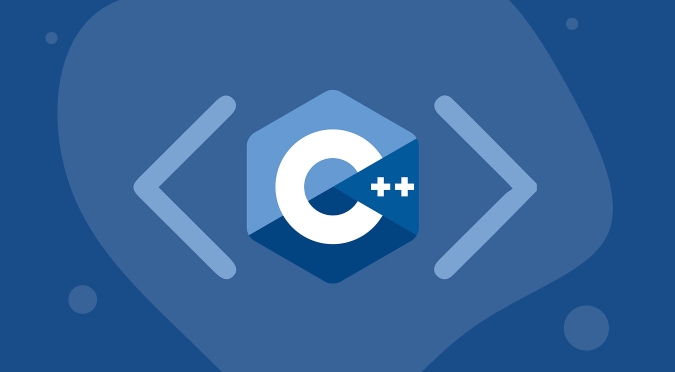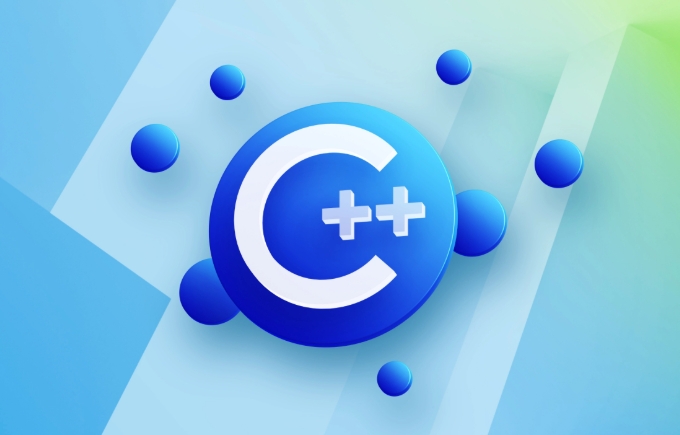What is STL (standard template library) in C? It contains four components: container, algorithm, iterator and function object. Containers such as vector, list, map and set are used to store data, algorithms such as std::sort() are used to operate elements in containers, iterators connect algorithms and containers, and function objects are used to customize algorithm behavior. Why use STL? 1. Save time: Direct calls have been efficiently implemented; 2. Efficiency: The code has been optimized and widely tested; 3. Flexibility: The template supports multiple data types; 4. Portability: Cross-platform compatibility as part of the C standard. How to get started with STL containers? Taking vector as an example, you can introduce the header file through #include, add elements using push_back, access the elements through [] or at(), and check whether they are empty before accessing. Common errors include forgetting to include header files, misuse of iterators, unreasonable use of const, and excessive use of dynamic memory. Mastering the basic containers and usage can improve coding efficiency and stability.

STL in C stands for the Standard Template Library . It's a powerful collection of pre-written C code that helps developers handle common data structures and algorithms without having to build them from scratch.

What's Included in the STL?
The STL is made up of four main components:

- Containers : These are objects that store data. Examples include
vector,list,map, andset. - Algorithms : These are functions that operate on containers, like sorting or searching. For example,
std::sort()can sort elements in a container. - Iterators : They act as pointsers to connect algorithms with containers. You use them to move through the elements in a container.
- Function Objects (Functors) : These are objects that can be used like functions. They're often used to customize behavior in algorithms.
This structure makes it easier to write clean, efficient, and reusable code.
Why Use the STL?
There are several practical reasons why developers rely on the STL:

- Time-saving : Instead of writing your own linked list or sorting function, you can just use
std::listorstd::sort. - Efficiency : The STL is optimized for performance, so you get well-tested and fast implementations.
- Flexibility : Because it uses templates, the same code works with different data types.
- Portability : Since it's part of the C standard, STL code works across different platforms and compilers.
If you're working on anything from small scripts to large applications, the STL can help reduce bugs and speed up development.
How to Start Using STL Containers
Let's take one of the most commonly used containers — std::vector . It's like a dynamic array that can grow as needed.
Here's a simple example:
#include <vector>
#include <iostream>
int main() {
std::vector<int> numbers;
numbers.push_back(10);
numbers.push_back(20);
numbers.push_back(30);
for (int i = 0; i < numbers.size(); i) {
std::cout << numbers[i] << " ";
}
return 0;
}Some quick tips when using vectors:
- Use
.push_back()to add elements. - Access elements with
[ ]or.at()(the latter does bounds checking). - Always check if the vector is empty before accessing elements.
Other containers like map or unordered_map are great for key-value pairs, while stack and queue help with specific logic flows.
Common Mistakes to Avoid
Even experienced developers sometimes run into issues when using the STL. Here are a few pitfalls to watch out for:
- Forgetting to include headers : Each STL component lives in a specific header file. For example,
#include <vector></vector>or#include <map></map>must be present. - Mixing up iterators : Some operations invalidate iterators, which can cause crashes. For example, modifying a container while iterating over it might lead to undefined behavior.
- Not using const where appropriate : If your function doesn't need to modify a container, pass it by
const&to avoid unnecessary copies. - Overusing dynamic memory : STL containers manage their own memory, so avoid using raw points unless necessary.
Getting comfortable with these patterns take practice, but once you do, the STL becomes an essential tool in your C toolkit.
Basically that's it. Mastering basic containers and usage can make you write code faster and more stable.
The above is the detailed content of What is the STL in C ?. For more information, please follow other related articles on the PHP Chinese website!

Hot AI Tools

Undress AI Tool
Undress images for free

Undresser.AI Undress
AI-powered app for creating realistic nude photos

AI Clothes Remover
Online AI tool for removing clothes from photos.

Clothoff.io
AI clothes remover

Video Face Swap
Swap faces in any video effortlessly with our completely free AI face swap tool!

Hot Article

Hot Tools

Notepad++7.3.1
Easy-to-use and free code editor

SublimeText3 Chinese version
Chinese version, very easy to use

Zend Studio 13.0.1
Powerful PHP integrated development environment

Dreamweaver CS6
Visual web development tools

SublimeText3 Mac version
God-level code editing software (SublimeText3)

Hot Topics
 C Polymorphism : is function overloading a kind of polymorphism?
Jun 20, 2025 am 12:05 AM
C Polymorphism : is function overloading a kind of polymorphism?
Jun 20, 2025 am 12:05 AM
Yes, function overloading is a polymorphic form in C, specifically compile-time polymorphism. 1. Function overload allows multiple functions with the same name but different parameter lists. 2. The compiler decides which function to call at compile time based on the provided parameters. 3. Unlike runtime polymorphism, function overloading has no extra overhead at runtime, and is simple to implement but less flexible.
 What Are the Different Kinds of Polymorphism in C ? Explained
Jun 20, 2025 am 12:08 AM
What Are the Different Kinds of Polymorphism in C ? Explained
Jun 20, 2025 am 12:08 AM
C has two main polymorphic types: compile-time polymorphism and run-time polymorphism. 1. Compilation-time polymorphism is implemented through function overloading and templates, providing high efficiency but may lead to code bloating. 2. Runtime polymorphism is implemented through virtual functions and inheritance, providing flexibility but performance overhead.
 C : Is Polymorphism really useful?
Jun 20, 2025 am 12:01 AM
C : Is Polymorphism really useful?
Jun 20, 2025 am 12:01 AM
Yes, polymorphisms in C are very useful. 1) It provides flexibility to allow easy addition of new types; 2) promotes code reuse and reduces duplication; 3) simplifies maintenance, making the code easier to expand and adapt to changes. Despite performance and memory management challenges, its advantages are particularly significant in complex systems.
 C Destructors: Common Errors
Jun 20, 2025 am 12:12 AM
C Destructors: Common Errors
Jun 20, 2025 am 12:12 AM
C destructorscanleadtoseveralcommonerrors.Toavoidthem:1)Preventdoubledeletionbysettingpointerstonullptrorusingsmartpointers.2)Handleexceptionsindestructorsbycatchingandloggingthem.3)Usevirtualdestructorsinbaseclassesforproperpolymorphicdestruction.4
 Polymorphism in C : A Comprehensive Guide with Examples
Jun 21, 2025 am 12:11 AM
Polymorphism in C : A Comprehensive Guide with Examples
Jun 21, 2025 am 12:11 AM
Polymorphisms in C are divided into runtime polymorphisms and compile-time polymorphisms. 1. Runtime polymorphism is implemented through virtual functions, allowing the correct method to be called dynamically at runtime. 2. Compilation-time polymorphism is implemented through function overloading and templates, providing higher performance and flexibility.
 C tutorial for people who know Python
Jul 01, 2025 am 01:11 AM
C tutorial for people who know Python
Jul 01, 2025 am 01:11 AM
People who study Python transfer to C The most direct confusion is: Why can't you write like Python? Because C, although the syntax is more complex, provides underlying control capabilities and performance advantages. 1. In terms of syntax structure, C uses curly braces {} instead of indentation to organize code blocks, and variable types must be explicitly declared; 2. In terms of type system and memory management, C does not have an automatic garbage collection mechanism, and needs to manually manage memory and pay attention to releasing resources. RAII technology can assist resource management; 3. In functions and class definitions, C needs to explicitly access modifiers, constructors and destructors, and supports advanced functions such as operator overloading; 4. In terms of standard libraries, STL provides powerful containers and algorithms, but needs to adapt to generic programming ideas; 5
 What Are the Various Forms of Polymorphism in C ?
Jun 20, 2025 am 12:21 AM
What Are the Various Forms of Polymorphism in C ?
Jun 20, 2025 am 12:21 AM
C polymorphismincludescompile-time,runtime,andtemplatepolymorphism.1)Compile-timepolymorphismusesfunctionandoperatoroverloadingforefficiency.2)Runtimepolymorphismemploysvirtualfunctionsforflexibility.3)Templatepolymorphismenablesgenericprogrammingfo
 C Polymorphism: Coding Style
Jun 19, 2025 am 12:25 AM
C Polymorphism: Coding Style
Jun 19, 2025 am 12:25 AM
C polymorphismisuniqueduetoitscombinationofcompile-timeandruntimepolymorphism,allowingforbothefficiencyandflexibility.Toharnessitspowerstylishly:1)Usesmartpointerslikestd::unique_ptrformemorymanagement,2)Ensurebaseclasseshavevirtualdestructors,3)Emp






